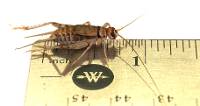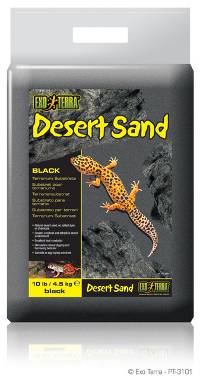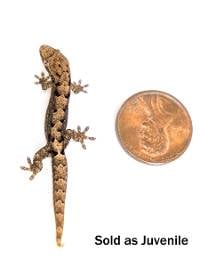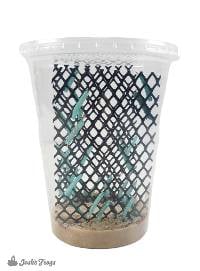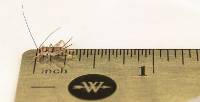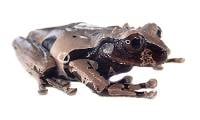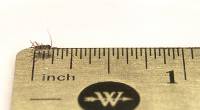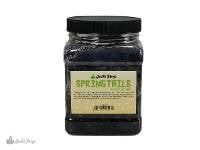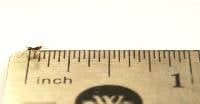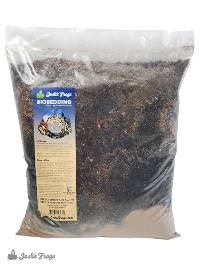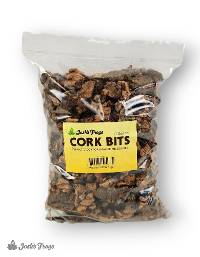Josh's Frogs
Why you should buy from us
Dune Gecko - Stenodactylus sthenodactylus (Captive Bred)
Dune Gecko - Stenodactylus sthenodactylus (Captive Bred)
$59.99 0.0 out of 5 stars
(0)
0.0 out of 5 stars
(0)About This Product
Defining characteristics:
- Brown, sandy colored
- Sand-loving diggers
- Nocturnal
- Terrestrial
- Endemic to Africa
Name: Stenodactylus sthenodactylus, most commonly known as the Dune Gecko, but also known as the Dwarf Sand Gecko, Elegant Gecko, or Lichtenstein’s Short-Fingered Gecko.
Recommended Enclosure Size & Setup: Due to their small size, up to 4 dune gecko adults can be housed in an 18x18x12 enclosure, with larger sized enclosures housing more animals. Male and females of this communal species can be housed together with no issues, provided enough space and food.
Dune geckos are largely terrestrial and love digging. Naturally derived sand, such as ReptiSand or Fluker's natural Sand, is the ideal substrate for this species. Substrate should be at least 4 inches deep. So long as the animals are kept healthy and husbandry parameters are correct, impaction is not a risk. The sand should be spot cleaned (i.e. feces and urates removed) once a week.
This species is nocturnal and will hide under cage items during the day. Many items such as small cork flat pieces, live oak bark, and everyday items like overturned plant saucers can all be utilized as hides for this species, who will excavate and even bury cage items over time. Make sure that any cage items that are placed on the sand are light; these geckos will absolutely dig under everything! If heavier items are used, like slate, then they must be supported by the bottom of the enclosure instead of just the sand to avoid collapse over a digging animal.
Temperature (°F): Dune geckos can be kept at ambient temperatures of 75-85 degrees. A basking spot of around 95 degrees during the day must be provided. Training an overhead basking bulb onto slate tile or a partially buried ceramic pot is an excellent way to achieve this; if they can, they will bask in the radiant heat underneath their basking site.
UV lighting is strongly recommended. Not only will they synthesize D3 from ambient UVB radiation and incidental exposure, but they will also use the UVA wavelengths visible to all reptiles to properly inform basking behavior and circadian rhythm. UV lighting should be focused on their basking site. Temperature should be monitored with a digital thermometer, and the basking spot can be checked with an infrared thermometer or temperature gun.
Humidity: The ambient humidity on the surface should be no greater than 40-50%. Substrate should have a moisture gradient, with the top layer being allowed to completely dry, and the bottom layer kept moist but not waterlogged. Ambient humidity can be monitored with a digital hygrometer. A small, shallow water dish can be provided, but is not necessary with regular misting. This species should be misted one to three times a week, with the goal of providing droplets of water on the walls of the enclosure from which the geckos may drink, as well as maintaining proper moisture levels in the substrate.
The enclosure should have enough ventilation so that the surface dries within a few hours of misting.
Size: This small species hatches out at barely an inch, and adults will only reach around 3 inches from head to tail as adults!
Age: It is estimated that this species can live up to 10-15 years in captivity. Individuals for sale are at least 4 weeks old.
Feeding: Dune geckos are insectivores and thrive on a diet of feeder insects. Fortunately, we provide all of the feeder bugs you will need! A staple of crickets and dubia works best, with other feeder insects (waxworms, mealworms, black soldier fly larvae, etc..) being offered as occasional treats. Dune Geckos can handle insect feeders ranging from 0.25 to 0.5 inches, favoring small prey items when they are young, and gradually taking on larger prey as they age.
Offering insects in an escape-proof feeding bowl will minimize the number of bugs that escape and hide among the enclosure. Once weekly, feeder insects should be lightly dusted with a calcium and multivitamin supplement.
If provided proper UV lighting, we recommend Repashy Calcium Plus LoD, otherwise, Calcium Plus should be offered to account for the lack of natural Vitamin D3 creation.
Sexing: Male geckos can be told apart from females by the presence of a hemipenal bulge and their more slender appearance.
Color/Pattern: Dune geckos have a white belly and a back displaying beige, brown, and sometimes even yellow colors. Wild-type geckos exhibit a variety of patterns, including irregular stripes and blotches. This wide variety of irregular patterns along with their subtly translucent skin makes these geckos very unique.
Social Behavior: Dune geckos are a communal species; provided enough food and space, both males and females can be housed together with no issues. Keep in mind that housing males and females together will invariably result in eggs.
Breeding: A mild brumation period in the winter is required . During the breeding season, females will lay two eggs in the substrate around every 2 weeks, which can be carefully removed and incubated. Eggs will hatch within 60-80 days.
Natural Range: Dune geckos are found throughout northeastern Africa, as well as in some parts of the middle east. They are most commonly found at or near sandy, dry riverbeds, where they dig down and create burrows.
History in the Hobby: Dune Geckos can be found throughout the hobby, however, finding them captive bred can be difficult. We’re very excited to share the success we’ve had with our captive Dune Gecko breeding projects with you!
Links of Interest:
- AmphibianCare Care Sheet - a care sheet on Stenodactylus species
- Supreme Gecko Care Sheet - Supreme Gecko care sheet on Stenodactylus sthenodactylus
Still not sure if the dune gecko from Josh's Frogs is the right pet for you? Read the reviews below and see what other customers are saying!
Shipping
After placing an order containing a live animal, you will receive a scheduling email containing our JotForm scheduling link to schedule your new pet's delivery date.
With this scheduling link, you will be able to schedule your order's delivery up to 30 days in advance. You will be able to choose a date of delivery for Tuesday-Saturday (Saturday arrival depends on the carrier's service availability) with the estimated time of arrival generally being 12pm, or 4:30pm for more rural areas. Overnight lows must be above 40°F to ship directly to you (or above 30°F for FedEx Ship Center pickups) as well as below 90°F by estimated time of arrival.
If you require further assistance, or prefer to talk to one of our Customer Service agents, please feel free to reach out to our [email protected] email or our phone line 1-800-691-8178.
Other Customers Also Bought
Customer Reviews
0.0 out of 5 stars
Review data
5 star reviews
- 0%
4 star reviews
- 0%
3 star reviews
- 0%
2 star reviews
- 0%
1 star reviews
- 0%


